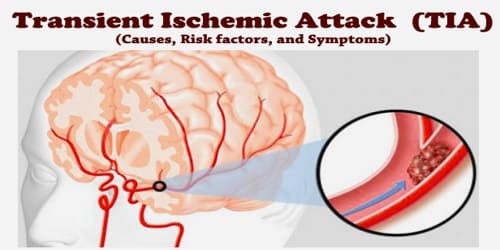TIAs are sometimes called “mini-strokes,” because their symptoms last only for a few minutes and ranging up to 24 hours before disappearing. But “warning stroke” is a better label, because a TIA often foreshadows a full-blown stroke and needs to be taken seriously.
Transient Ischemic Attacks are caused by a clot or blockage in the brain. The blockage is short term. The clot usually dissolves on its own or gets dislodged, and symptoms usually last for a short time.The risk of having a full-blown stroke is highest in the 90 days following a TIA. About 9 to 17 percent of patients who have a TIA have a stroke within 90 days. If you’re worried that you’re having a transient ischemic attack or TIA, get medical help right away. If you think you might’ve had one in the past, do your homework and talk with your doctor. TIAs are often followed by more severe strokes.
Risk Factors and Treatments
Anyone can have a TIA but the risk increases with age. If you’ve previously had a stroke, pay careful attention to the signs of TIA, because they could signal a second stroke in your future. The risk factors are smoking, cardiovascular disease, diabetes and blood clots called embolisms. Get help immediately if you think you could be having a TIA. Trained medical staff will need to evaluate your condition. Some causes are only visible with hospital equipment. When a TIA occurs in a young person with no clear risk factors, the patient might be sent to a neurologist for testing to rule out vasculitis, carotid artery dissection and other types of injury or infection.
Warning signs
- Weakness, numbness or paralysis on one side of your body
- Slurred speech or difficulty understanding others
- Blindness in one or both eyes
- Dizziness
- Severe headache with no apparent cause
A TIA can signal a future stroke. Take the warning seriously and don’t delay.TIAs are often a warning sign for future strokes. Taking medicine, such as blood thinners, may reduce your risk of a stroke. Your doctor might also recommend surgery. You can also help lower your risk by having a healthy lifestyle. This includes not smoking, not drinking too much, eating a healthy diet, and exercising. It is also important to control other health problems, such as high blood pressure and cholesterol.TIAs typically happen because a blood clot gets lodged in an artery that supplies blood to the brain. Without regular blood flow, your brain is starved for oxygen and can’t work like it normally does.That’s why you get symptoms like muscle weakness or slurred speech. It would be like having a clogged fuel line in your car. Your engine can’t run if it’s not getting gas.
Neuro specialist of Delhi and one of the best stroke neurologists of India, Dr P N Renjen, states,” Clots form when you have a buildup of a fatty, waxy substance called plaque in your arteries. They can take shape anywhere in your body and float along until they get stuck somewhere. If that “somewhere” happens to be an artery that goes to your brain, you can have a TIA.You can also get a TIA if so much plaque builds up in an artery that it severely limits blood flow to the brain, just like a clot.The main difference is that a TIA only lasts a few minutes. The clot then gets pushed along, like a temporary clog in a pipe, or chemicals in your body quickly break it down. Normal blood flow returns to your brain before any lasting problems set in. Symptoms can last for up to 24 hours, but they’re usually gone in an hour.
Strokes, on the other hand, don’t go away so quickly. That means some part of your brain goes without oxygen, and the longer that lasts, the more damage happens. While a TIA comes on, goes away, and leaves no symptoms, a stroke can have long-lasting effects and can be life-threatening.
The risk factors for TIA are the same as for ischemic stroke. Things that can make you more likely to have a stroke include your age, lifestyle, ethnicity, and family history of stroke.
When you are diagnosed with TIA, you’ll be given advice about your individual risk factors. You’ll be offered support with lifestyle changes such as quitting smoking and being more active.
Some of the best centres for stroke treatment in Delhi offer end to end medical expertise for the treatment of a stroke.

